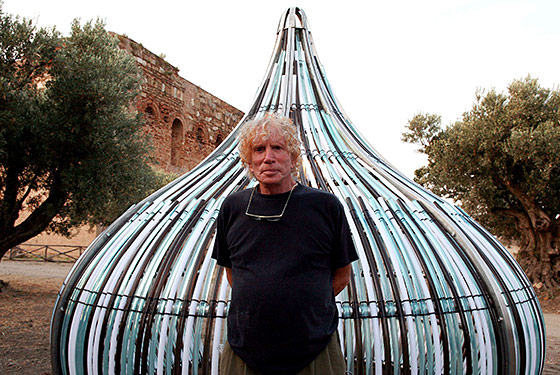
I had glimpsed Dennis Oppenheim around the art world for decades. The artist, who died of liver cancer on January 22 at 72, was a beautiful bottle-blond — cute and disheveled, like a rock star, even into his last decade. He’d be at openings, across rooms, hunkered down at bars with artists, always with women. I only met him once. I was in my early thirties and interviewed him in his Tribeca studio for a book I was working on. I was interested in how and what he assigned to art students, to help them to expand their work. I didn’t understand a lot of what he said; he had a way of speaking in winding threads, less like an artist and more like a physicist-philosopher-metaphysician. Take these two points: “Make things that carry with them the residue of where they have been.” And “Make a sculpture in the way that you speak, as a projection that dissipates.”
But the wild, labyrinthical ways Oppenheim put things together, the way he allowed thought to unspool ever-outward in involuted configurations, was inspiring nonetheless. His ideas of artistic experimentation, theoretically driven art, the merging of sculpture and science, his absolute unwillingness to create a visual style, his aesthetic and material dislocation — all of it wowed me.
His earth works from the sixties and seventies were what first caught my attention — like when he seeded a Dutch field according to the topographical configuration of the land; or created a “landslide” of minimal sculptures along Exit 52 of the Long Island Expressway; or cut a channel in the ice of the St. Johns River at the United States–Canadian border. In 1968, he somehow got a hold of and removed four tons of debris from the floor of the New York Stock Exchange and relocated it onto a New York roof. He called this “free-moving architecture.”
Whatever Oppenheim’s work meant, you immediately got that he was taking art into the world, and bringing the world into his art. He had gone rogue. In 1970, he set up two cinder block walls beneath the Brooklyn Bridge then hung between them becoming a bridge himself. And that perhaps best symbolized Oppenheim’s work: He was a human bridge to thought structures that are out of reach yet familiar enough to be thrilling.
Around 1980 his work got a materially battier (though no less thrilling), when he began fabricating bizarre Rube Goldberg–like sculptures of spiral ramps leading nowhere, strange machines that looked like astrophysics generators, pretend factories with levers and moving parts that produced nothing but food for the imagination.
By the nineties, this great unruly speculative Conceptualist, this pioneering Body Artist, Earth Work Artist, and early explorer of postmodern sculpture, had fallen out of step with the art world. His objects became larger, more unwieldy, precarious, dangerous, and not at all at home in art galleries. He made twisted brick chimneys, reindeer sculptures with fire coming out of their horns — public art works I’ve never seen in places like Corvallis, Oregon; Charlotte, North Carolina; and Beijing, China.
But even then, Oppenheim remained adamantly experimental, conceptually dense, and visually experimental. He always maintained a stringently personal and highly resolved theoretical position. I loved the way he made discoveries, shared them, then moved on. This could also be frustrating and visually disconcerting and may explain why he ended up mainly making public sculpture. His later gallery shows were a Mardi Gras of noise, fire, moving objects, and mayhem — crazy and smart, but all over the place. Still, even surrounded by peers like Robert Smithson, Walter DeMaria, and Lawrence Weiner, Dennis Oppenheim was an artistic live wire and a Geiger counter of postmodern possibility.




